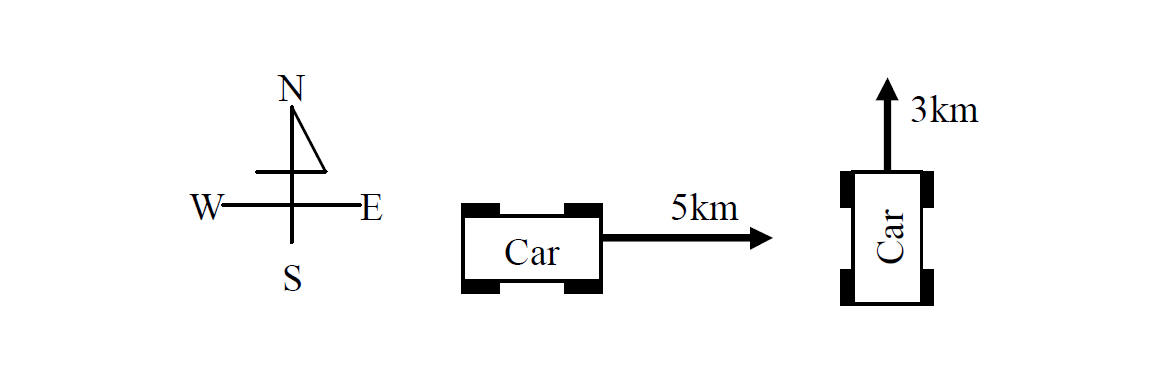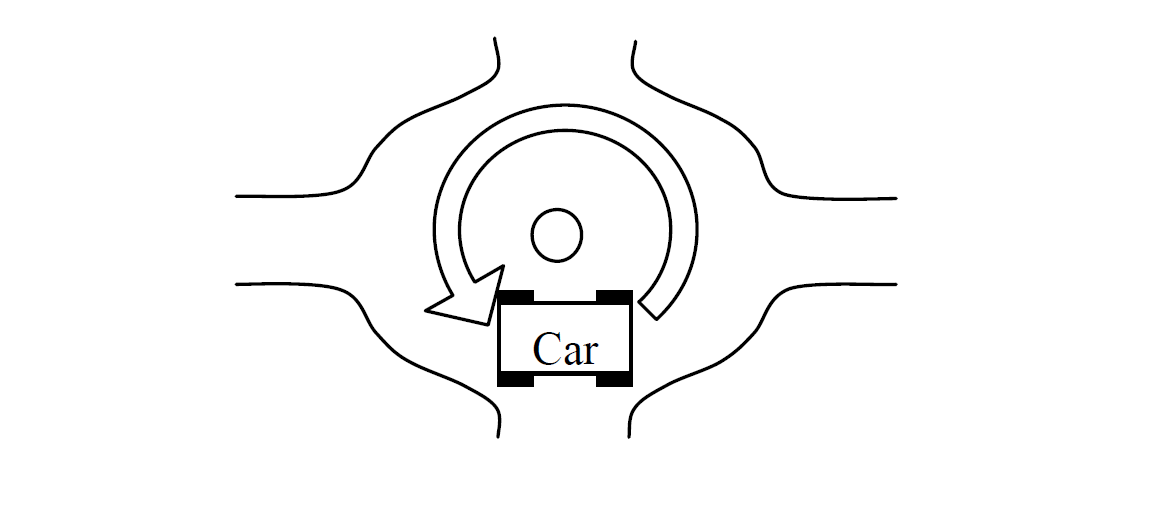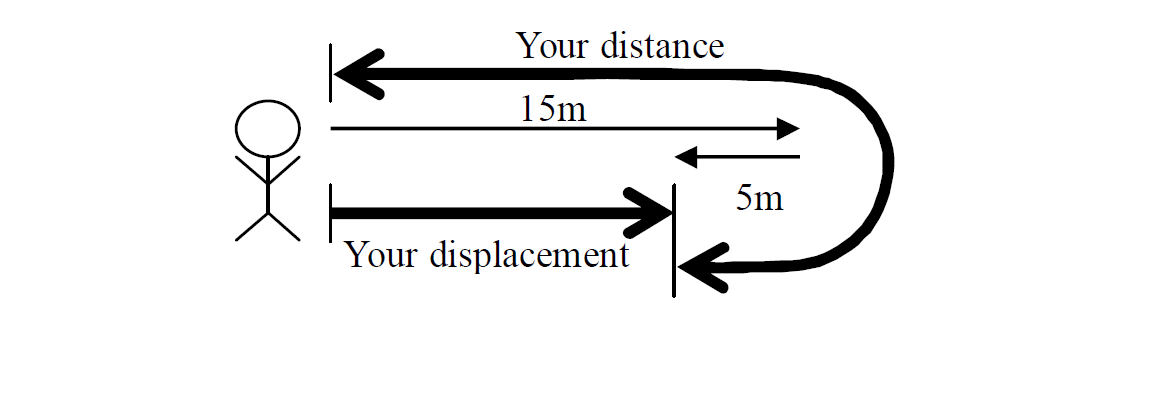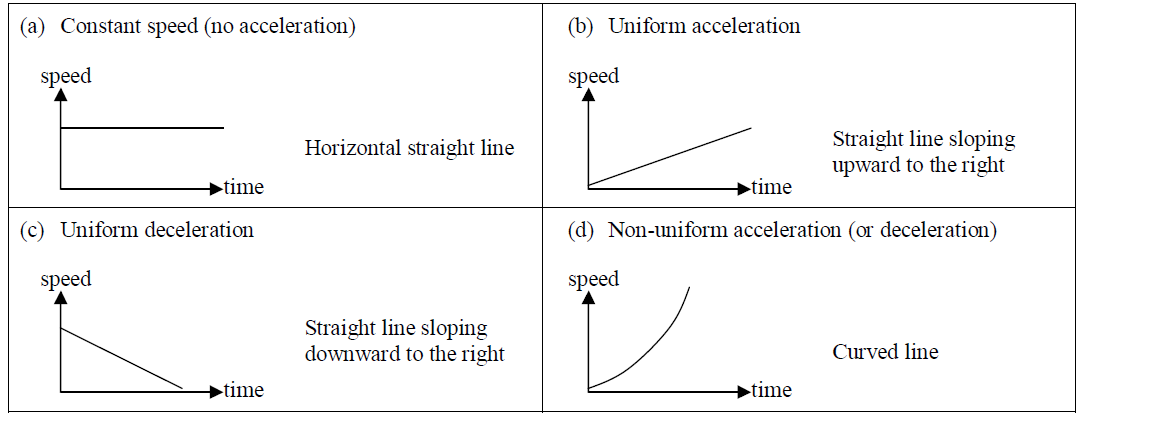Speed, Velocity and Acceleration
Distance and Displacement
Distance is defined as the total length taken between two points
- It is a scalar. meaning it is a quantity having magnitude only.
Displacement is defined as the change of position of a point in a particular direction
- It is a vector. meaning it is quantity having both magnitude and direction
SI units of both distance and displacement are metre [m].
Example 1
A car moves 5km to the East and 3km to the North. What is the distance and the displacement of the car?

Solutions
- Distance of the car is 8km (= 5km +3km).
- Displacement of the car is 5km East and 3km North.
Example 2
The circumference of a roundabout is 10m and the car turns it once. What is the distance and the displacement of the car?

Solutions
- Distance of the car is 10m
- Displacement of the car is 0m because it came back to the starting position
Example 3
You walk forward 15m and backward 5m. What is your distance and your displacement?

Solutions
Your distance is 20m (= 15m + 5m).
Your displacement is 10m (= 15m - 5m) forward.
Speed
Speed is defined as the rate of change of distance traveled with time. It is a scalar.
The unit of speed is metre per second [m/s].
Formula for Speed
Example
A car travels a distance of 540km from Lusaka to Katete in 10 hours. Find the average speed in km/hr and m/s.
Solution
given that:
Total distance traveled = 540km
Total time taken = 10hrs
Answer: Km/hr
or
Answer m/s
Velocity
Velocity is defined as the rate of change of displacement with time. It is a vector.
The unit of velocity is metre per second [m/s]. (It is the same unit as speed.)
Example
What are their speeds and their velocities?

Solution
They have the same speeds of 10m/s but they have different velocities.
Car1 has the velocity of 10m/s East.
Car2 has the velocity of 10m/s North.
Acceleration
Acceleration is defined as the rate of change of velocity with time. It is a vector.
The unit of acceleration is metre per second squared [m/s2].
Formula for Acceleration
a: Acceleration [m/s2]
v: final velocity [m/s]
u: initial velocity [m/s]
t: time taken [s]
Example 1
A car starting from rest increases its velocity uniformly to 15m/s in 5s. What is its acceleration?
Solution
Given that
V = 15 m/s
U = 0 m/s
t = 5s
Answer:
Example 2
If a car slows down from 72km/hr and stops in 10s, calculate the acceleration
Solution
Convert 72km/hr to m/s
Therefore the data is:
V = 0m/s
U = 20m/s
t = 10s
Answer:
When the velocity reduces, the acceleration becomes a negative number. The acceleration is called the retardation or deceleration.
Uniformly accelerated liner motion
If a body moves with a uniform acceleration (the acceleration is constant), three important equations are given below.
Formulas for uniform acceleration
1.
2.
3.
Note that:
a: Acceleration [m/s2]
v: final velocity [m/s]
u: initial velocity [m/s]
t: time taken [s]
x: distance covered [m]
Example 1
A car traveling at 10m/s accelerates at 2m/s2 for 3s. What is its final velocity?
Solution
Formula
Given that
U = 10m/s
t = 3s
a =
V = ?
Answer:
Example 2
A motorcycle starting from rest acquires a velocity of 72km/hr in 5s.
(a) What is its acceleration?
(b) How far does it travel during this time?
Solutions
(a)
Given that
V = 72km/hr = 20m/s
U = 0m/s
t = 5s
a = ?
Answer:
(b)
Given that
u = 0m/s
t = 5s
a = 4m/s2
x = ?
Note that: You can't use the formula: D=S×T. Because there is no acceleration.
Example 3
The velocity of an object is uniformly reduced from 50m/s to 30m/s. If the deceleration is –4m/s2, how much is the distance of the body decelerating?
Solution
Given that
u = 50m/s
v = 30m/s
a = -4m/s2
x = ?
Acceleration due to gravity
All objects accelerate uniformly towards the earth if air resistance is ignored. It is called acceleration due to gravity. It is represented by the symbol ‘g’.
g = 9.8m/s2 ≈ 10m/s2
Points to note
1. If a stone is dropped from the top of a tall building, it accelerates uniformly downwards. If you release a stone without applying force, it starts from rest. It is called free fall.
Free fall
u = 0m/s
a = g = 10m/s2
2. If you throw up a stone, the stone decelerates to the top. Then it stops momentarily at the top. And then it starts falling freely
Throwing up
v = 0m/s
a = -g = -10m/s2
Example 1
A body falls freely from rest. Air resistance is ignored. (g = 10m/s2)
(a) What is its velocity after 1s?
(b) How far does it reach in 1s?
Solutions
(a)
Given that
u = 0m/s
a = g = 10m/s2
t = 1s
v = ?
Answer:
(b)
Given that
u = 0m/s
a = g = 10m/s2
t = 1s
x = ?
Answer:
Speed (velocity) – time graph
Speed (velocity) – time graphs tell stories about the movement of an object.
- The gradient of the speed – time graph is equal to the acceleration of the object.
- The area under the speed – time graph represents the distance traveled by the object.
The diagrams below show the speed – time graphs for different kinds of motion.

Example
A car moving from rest acquires a velocity of 20m/s with uniform acceleration in 4s. It moves with this velocity for 6s and again accelerates uniformly to 30m/s in 5s. It travels for 3s at this velocity and then comes to rest with uniform deceleration in 12s.
(a) Draw a speed – time graph
(b) Calculate the total distance covered.
(c) Calculate the average speed.
Solutions
(a)

(b)
To find the total distance covered, calculate the area under the speed – time graph.
Area A = triangle =
Area B = rectangle = =
Area C = trapezium = =
Area D = rectangle = =
Area E = triangle =
Total distance covered = Total area = 40 + 120 + 125 + 90 + 180 = 555m
(c)
Answer: